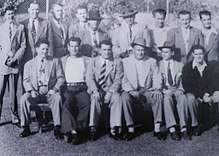Gangster Squad (LAPD)

The Gangster Squad (later known as the Organized Crime Intelligence Division (OCID)) was a special unit created by the Los Angeles Police Department in 1946 to keep the East Coast Mafia and organized crime elements out of Los Angeles.[1]
Origin
It was created by then Chief of Police Clemence B. Horrall in 1946, and it was an eight-man intelligence detail that would become known as the "Gangster Squad". Along with fighting organized crime, they were given the task of spying on corrupt cops. Criminals like Mickey Cohen, Jack Dragna, Bugsy Siegel, Jack Whalen, and Jimmy Fratianno—to name a few—were just some of the targets the Gangster Squad went after.
Preview
Much like what the 2013 film Gangster Squad notes about the real Gangster Squad, they waged war on crime and did things that would be considered illegal by today's standards. Also, as the real life Sgt. Jack O'Mara stated in the Los Angeles Times for the online article "Crusaders in the underworld: The LAPD takes on organized crime", "We did a lot of things that we'd get indicted for today".[2] William Worton headed up the LAPD in 1949 and increased the size of the team, as well as renaming it the Intelligence Division. William Parker became Chief of Police in 1950, and expanded the team even more, including adding a female field team.
In the media
- The 2013 film Gangster Squad—though taking considerable creative liberty—was based on the LAPD's Gangster Squad.
- Jack Webb's 1954 film Dragnet is based on the Intelligence Division, also known as the Gangster Squad.
- Author James Ellroy used a different, fictionalized version of the Gangster Squad called the "Mobster Squad", in his L.A. Quartet novels. The team is introduced in L.A. Confidential and is headed up by corrupt LAPD captain Dudley Smith. Their duties included beating confessions out of suspects, scaring criminals out of town, and controlling and containing crime.
- Similar units are depicted in the 1996 film Mulholland Falls, and in the 2013 miniseries Mob City the squad is referenced as "Horrall's gang of thugs".
- In the book L.A's Secret Police: Inside the Elite Spy Network former OCID detective Mike Rothmiller discusses how, during the 1970s and '80s, the OCID was more interested in celebrities and politicians than actual mobsters. He was denied permission to meet a major mob informant in Las Vegas but resources were spent having six officers staking out a politician's beach house because of possible homosexual activity.[3]
- The 1950 film 711 Ocean Drive depicts the Gangster Squad investigating a horse racing betting syndicate.
Notes
- ↑ Roe, Mike (10 January 2013). "PHOTOS: The real-life 'Gangster Squad' and mobster Mickey Cohen". Southern California Public Radio. Without a Net (blog). Retrieved 7 January 2014.
- ↑ Lieberman, Paul (26 October 2008). "Crusaders in the underworld: The LAPD takes on organized crime". Los Angeles Times. Retrieved 7 January 2014.
- ↑ https://www.amazon.com/dp/B008LW7DQ8/
References
- Lieberman, Paul (2012). Gangster Squad: Covert Cops, the Mob, and the Battle for Los Angeles. New York: Thomas Dunne Books. ISBN 9781250020154. OCLC 811627745.
- Wolfe, Donald H. (2005). The Black Dahlia Files: The Mob, the Mogul, and the Murder That Transfixed Los Angeles. New York: HarperCollins. ISBN 9780060582494. OCLC 62726017.
Further reading
- Kinchen, David M. (14 August 2012). "BOOK REVIEW: 'Gangster Squad': Secretive L.A.P.D. Unit Goes After Mobsters in Post WW II Los Angeles". The Huffington Post. Retrieved 7 January 2014.
- Lieberman, Paul. "L.A. Noir: Tales from the Gangster Squad". Los Angeles Times. Retrieved 7 January 2014. A series of seven articles run from 26 October to 1 November 2008.
External links

